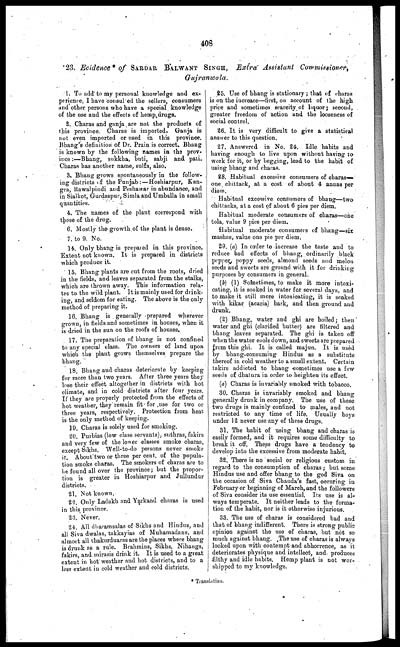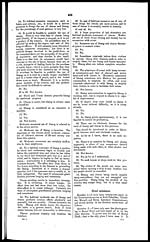Medicine - Drugs > Report of the Indian Hemp Drugs Commission, 1894-1895 > Volume V
(428) Page 408
Download files
Individual page:
Thumbnail gallery: Grid view | List view

408
23.Evidence* of SARDAR BALWANT SINGH, Extra Assistant Commissioner,
Gujranwala.
1.To add to my personal knowledge and ex-
perience, I have consul ed the sellers, consumers
and other persons who have a special knowledge
of the use and the effects of hemp, drugs.
2.Charas and ganja are not the products of
this province. Charas is imported. Ganja is
not even imported or used in this province.
Bhang's definition of Dr. Prain is correct. Bhang
is known by the following names in the prov-
ince:—Bhang, sukkha, buti, sabji and pati.
Charas has another name, sulfa, also.
3.Bhang grows spontaneously in the follow-
ing districts of the Punjab:— Hoshiarpur, Kan-
gra, Rawalpindi and Peshawar in abundance, and
in Sialkot, Gurdaspur, Simla and Umballa in small
quantities.
4.The names of the plant correspond with
those of the drug.
6.Mostly the growth of the plant is dense.
7.to 9. No.
14.Only bhang is prepared in this province.
Extent not known. It is prepared in districts
which produce it.
15.hang plants are cut from the roots, dried
in the fields, and leaves separated from the stalks,
which are thrown away. This information rela-
tes to the wild plant. It is mainly used for drink-
ing, and seldom for eating. The above is the only
method of preparing it.
16.Bhang is generally -prepared wherever
grown, in fields and sometimes in houses, when it
is dried in the sun on the roofs of houses.
17.The preparation of bhang is not confined
to any special class. The owners of land upon
which the plant grows themselves prepare the
bhang.
18.Bhang and charas deteriorate by keeping
for more than two years. After three years they
lose their effect altogether in districts with hot
climate, and in cold districts after four years.
If they are properly protected from the effects of
hot weather, they remain fit for use for two or
three years, respectively. Protection from heat
is the only method of keeping.
19.Charas is solely used for smoking.
20.Purbias (low class servants), suthras, fakirs
and very few of the lower classes smoke charas,
except Sikhs. Well-to-do persons never smoke
it. About two or three per cent. of the popula-
tion smoke charas. The smokers of charas are to
he found alt over the province; but the propor-
tion is greater in Hoshiarpur and Jullundur
districts.
21.Not known.
22.Only Ladakh and Yarkand charas is used
in this province.
23.Never.
24.All dharamsalas of Sikhs and Hindus, and
all Siva dwalas, takkayias of Muhamadans, and
almost all thakurduaras are the places where bhang
is drunk as a rule. Brahmins, Sikhs, Nihangs,
fakirs, and mirasis drink it. It is used to a great
extent in hot weather and hot districts, and to a
less extent in cold weather and cold districts.
25.Use of bhang is stationary; that of charas
is on the increase—first, on account of the high
price and sometimes scarcity of liquor; second,
greater freedom of action and the looseness of
social control.
26.It is very difficult to give a statistical
answer to this question.
27.Answered in No. 24. Idle habits and
having enough to live upon without having to
work for it, or by begging, lead to the habit of
using bhang and charas.
28.Habitual excessive consumers of charas—
one chittack, at a cost of about 4 annas per
diem.
Habitual excessive consumers of bhang—two
chittacks, at a cost of about 6 pies per diem.
Habitual moderate consumers of charas—one
tola, value 9 pies per diem.
Habitual moderate consumers of bhang—six
mashas, value one pie per diem.
29.(a) In order to increase the taste and to
reduce bad effects of bhang, ordinarily black
pepper, poppy seeds, almond seeds and melon
seeds and sweets are ground with it for drinking
purposes by consumers in general.
(b) (1) Sometimes, to make it more intoxi-
cating, it is soaked in water for several days, and
to make it still more intoxicating, it is soaked
with kikar (acacia) bark, and then ground and
drunk.
(2) Bhang, water and ghi are boiled; then
water and ghi (clarified butter) are filtered and
bhang leaves separated. The ghi is taken off
when the water cools down, and sweets are prepared
from this ghi. It is called majun. It is used
by bhang-consuming Hindus as a substitute
thereof in cold weather to a small extent. Certain
takirs addicted to bhang sometimes use a few
seeds of dhatura in order to heighten its effect.
(a) Charas is invariably smoked with tobacco.
30.Charas is invariably smoked and bhang-
generally drunk in company. The use of these
two drugs is mainly confined to males, and not
restricted to any time of life. Usually boys
under 12 never use any of these drugs.
31.The habit of using bhang and charas is
easily formed, and it requires some difficulty to
develop into the excessive from moderate habit.
32. There is no social or religious custom in
regard to the consumption of charas; but some
Hindus use and offer bhang to the god Siva on
the occasion of Siva Chauda's fast, occuring in
February or beginning of March, and the followers
of Siva consider its use essential. Its use is al-
ways temperate. It neither leads to the forma-
tion of the habit, nor is it otherwise injurious.
33.The use of charas is considered bad and
that of bhang indifferent. There is strong public
opinion against the use of charas, but not so
much against bhang. The use of charas is always
looked upon with contempt and abhorrence, as it
deteriorates physique and intellect, and. produces
filthy and idle habits. Hemp plant is not wor-
shipped to my knowledge.
Translation.
Set display mode to: Large image | Zoom image | Transcription
Images and transcriptions on this page, including medium image downloads, may be used under the Creative Commons Attribution 4.0 International Licence unless otherwise stated. ![]()
| India Papers > Medicine - Drugs > Report of the Indian Hemp Drugs Commission, 1894-1895 > Volume V > (428) Page 408 |
|---|
| Permanent URL | https://digital.nls.uk/75122132 |
|---|
| Description | Volume 5: Evidence of witnesses from North-Western Provinces and Oudh and Punjab. Answers from witnesses in North-Western Provinces, Oudh and Punjab about cultivation and growth of hemp, preparation or manufacture, trade, consumption or use, effects, administration - taxation and control. |
|---|---|
| Attribution and copyright: |
|




